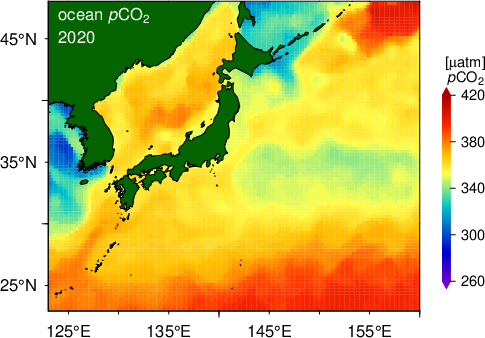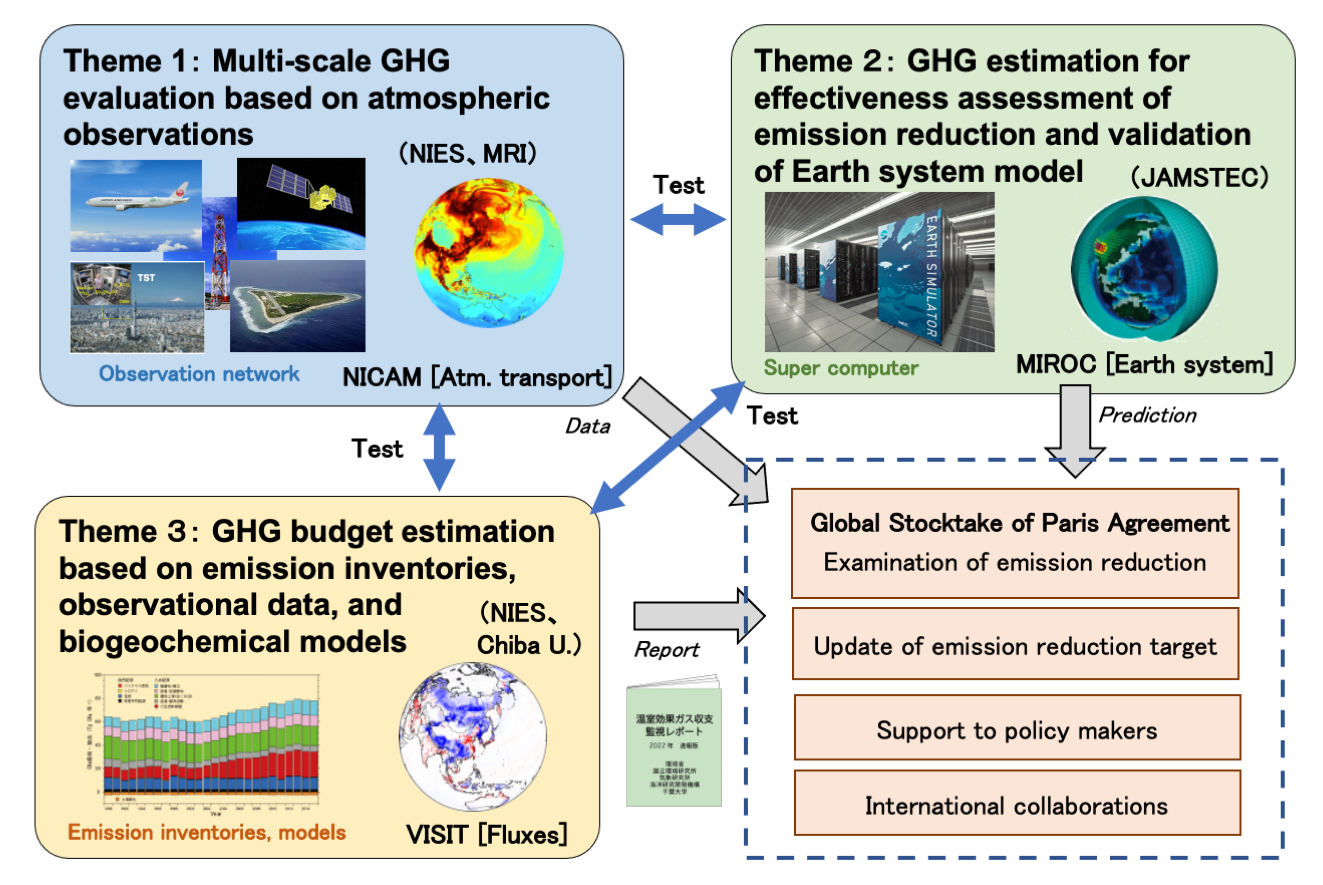Strategic R&D Area Project of the Environment Research and Technology Development Fund
SII-8 Comprehensive Study on Multi-scale Monitoring and Modeling of Greenhouse Gas Budgets
Period: FY R3 to R5(FY 2021 to 2023)Systematic project number: JPMEERF21S20800

1. Introduction
At the Conference of Parties of the United Nation Framework Convention of Climate Change at Paris in 2015, international communities reached an agreement about the future strategy on reduction of anthropogenic greenhouse gases (GHGs). The goal of the Paris Agreement is to limit global warming to well below 2°C, preferably to 1.5°C, compared to pre-industrial levels.
To achieve this goal, participant countries submitted their own nationally determined contribution (NDC) to reduce greenhouse gas emissions. However, it is still difficult to evaluate greenhouse gas budget [note 1] at national and regional scales with sufficient accuracy, and then scientific and objective assessment is highly required.
Under the Paris Agreement, the Global Stocktake will be performed from 2023 at every 5 years, aiming at confirming achievement of the NDC, investigating its sufficiency to fulfill the goal, and updating the NDC. To this end, several projects were launched in Europe and United States to establish a system to monitor greenhouse gases with the best-effort accuracy, using scientific procedures such as observations and modeling. Nevertheless, such system has not been established in Japan and Asia, making it difficult to report greenhouse gas budget promptly.

2. Outline of the project
This project conducts observational and modeling studies to establish a system (Multi-EGGS; Multi-scale/approach Estimation of Greenhouse Gas budgetS) to monitor greenhouse gases (CO2, CH4, and N2O) with a shorter time-lag and higher accuracy.
The system would contribute to the Global Stocktake of the Paris Agreement by providing scientific evidence of national and regional greenhouse gas budget. By elucidating global sinks, sources, and transport of greenhouse gases, this project will be effective to understand the mechanisms and make predictions of global warming.
Furthermore, by quantifying emissions from mega cities, this project would support accomplishment of decarbonization of cities. This project consists of three themes and progressively conducts various kinds of studies, on the advice of advisory board and program officer.

[1] Multi-scale GHG evaluation based on atmospheric observations
This theme conducts observations of atmospheric GHGs with various platforms such as ground station, aircraft, shipboard, satellite and conducts model analyses using the data (top-down approach). We establish a system for continuous monitoring and speedy reporting of GHG budget at various spatial scales from big cities to the globe. These activities will deepen our mechanistic understanding on carbon budget and its interannual variability at various scales. Furthermore, we propose an observation system necessary for evaluation of GHG budget using a newly developed observation method.
Sub-theme (1). Examination of observational network and GHG budge evaluation with atmospheric model
Sub-theme (2). Monitoring of atmospheric GHG dynamics with ground station and aircraft
Sub-theme (3). Refinement of ocean CO2 flux data based on ship observations

[2] GHG estimation for effectiveness assessment of emission reduction and validation of Earth system model
This theme conducts global-scale evaluations of atmospheric GHG dynamics and corresponding GHG budget, using global models and observational data supplied from Theme 1. We conduct studies for validation of GHG dynamics in the Earth system model [note 2] and then for improving the reliability of effectiveness evaluation of near-future emission reductions such as NDC by the Paris Agreement.
Sub-theme (1). Effectiveness assessment of GHG emission reduction using Earth system model
Sub-theme (2) Evaluation of global GHG budget change by top-down method

[3] GHG budget estimation based on emission inventories, observational data, and biogeochemical models
This theme conducts GHG evaluations using the bottom-up approach with emission inventories [note 3] and biogeochemical models, and then integrated assessments using multiple approaches in collaboration with themes 1 and 2. We establish a system to monitor and report GHG budget, which is applicable to quick reporting for periodic obligations like Global Stocktake and unpredictable events such as extreme weather and severe wildfires. The system integrates a series of procedures from individual observation to assessment report. Furthermore, we attempt to improve GHG budget by refining various kinds of emission inventories of fossil fuel combustion, land-use change, and wildfire, in which substantial uncertainties remain.
Sub-theme (1). Bottom-up evaluation and analysis of GHG budget including anthropogenic emission inventories
Sub-theme (2) Evaluation of terrestrial GHG budget by integrated analysis of observational data and model estimation

Terminologies
1:Greenhouse gas budget
Atmospheric concentrations of greenhouse gases (mainly CO2, CH4, and N2O) are influenced by various natural and anthropogenic sources and sinks. These sinks, sources, and net balance for certain spatial area (for example, country, region, global, and city) is called ‘budget’.
2:Earth system model
To make future climate prediction, numerical models that simulate atmospheric and oceanic motion and energy transport have been used. At present, more integrated models, called Earth system models, are used to include carbon cycle, greenhouse gas budget, and related biological and social activities.
3:Emission inventory
Datasets that include the amount of greenhouse gas emissions from human activities such as industry, agriculture, transport, fossil fuel mining, and energy consumption, are called ‘inventory’. These data are produced using various socioeconomic data such as fossil fuel consumption and energy use, but there remain problems in data accuracy and standardization of data aggregation.
Project Summary
Interlinkage between themes 1 and 2, 2 and 3, and 1 and 3: Mutual test for validation.
Using data from Theme 1, prediction data from Theme 2, and report from Theme 3.
Theme 1:Multi-scale evaluation of GHG budgets based on atmospheric observations
Research groups: NIES, MRI
Contents: Observation network by ground, ship, aircraft, and satellite platforms and atmspheric transport model [NICAM].
Theme2:GHG estimation for effectiveness assessment of emission reduction and validation of Earth system model
Research groups: JAMSTEC
Contents: Assessment with Earth system model [MIROC] working on super computers
Theme 3:GHG budget estimation based on emission inventories, observational data, and biogeochemical models
Research groups: NIES, Chiba University
Contents: Sectoral and temporal GHG budgets using emission inventories and flux model [VISIT]
Research outputs:Contribution to Global Stocktake of Paris Agreement
- -Examination of emission reduction
- -Update of emission reduction target
- -Support to policy makers
- -International collaborations


